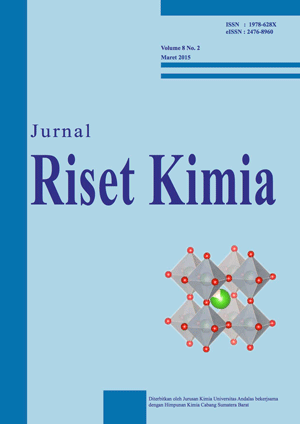DEGRADASI SENYAWA IMIDAKLOPRID SECARA ADVANCED OXIDATION PROCESSES DENGAN PENAMBAHAN TIO2-ANATASE
DOI:
https://doi.org/10.25077/jrk.v8i2.225Abstract
Imidacloprid is active compounds in Confidor 200 SL with have toxical character. Degradation of Imidacloprid in Advanced Oxidation Processes (AOPs) method by using TiO2 catalyst can reduce toxic level. Advanced Oxidation Processes (AOPs) method which is used is Sonolysis, Photolysis, and Ozonolisis. The result of sonolysis, Photolysis, and Ozonolysis measured by spectrophotometer UV-Vis with λ 400-600 nm, and than optimum degradation waste after addition of catalys measured by HPLC. The result of degradation of Imidacloprid 6 mg/L using sonolysis without addition catalys is more smallest from addition catalys which degradated in 60 minute, temperature 25±1 °C. At the same time with Photolysis methode for addition catalys we get the degradation is more biggest from addition catalys. Degradation percentage of imidacloprid without addition of TiO2-anatase reach is small from with addition of TiO2. Measure using HPLC for each methode we get more than one peak in chromatogram. It means there are other coumpounds in imidacloprid solution.
References
Zuraida. Pedoman Pengawasan Pestisida, Balai Perlindungan Tanaman Pangan dan Holtikultura, Sumatera Barat, (2004).
Yulianto, M. E., D. Handayani and Silviana, Kajian Pengolahan Limbah Industri Fatty Alkohol dengan Tekhnologi Photokatalitik Menggunakan Energi Surya. Gema Teknologi, (2005).
Kuo, W. S., and P. H. Ho. Solar Photocatalytic Decolorization of Methylene Blue in Water, J. Chemosphere. 45: 77–83 (2001).
Tietze, L. F., M. Bratz. Ozonolysis Mechanism on Organic Chemistry. Org. Syn. Coll., 9 314, (1998).
Xu, Xian-wen, S. Hui-xiang, and W. Da-hui. Ozonation with ultrasonic enhancement of p-nitrophenoI wastewater, J. Zhejiang Univ. Science B. 5: 319-323, (2005).
Weng, J, B. Guo, X. Zhang, Z. Zhang, J. Han, and J. Wu. Sonocatalytic Degradation of Methyl Orange in the Present of TiO2 Catalysts and Catalytic Activity Comparison of Rutile and Anatase. J. Ultrasonics Sonochemistry. 12: 331-337, (2005).
A. Syukri, Safni, P.P. Roza. Degradasi Senyawa Rhodamin B Secara Sonolisis dengan Penambahan TiO2 Hasil Sintesa Melalui Proses Sol-Gel. J. Ris. Kim. 1: 64 – 69, (2007).
A. Hakim, Safni, H. Suyani, T. Sakai. Degradasi Senyawa 2,4 (Diklorofenoksi) Asam Asetat Dalam Pestisida Sidamin 865 AS Secara Fotolisis Dengan Penambahan TiO2-Anatase. J. Ris. Kim. 3: 1 – 7, (2009).
N. Yenni, Safni, and H. Suyani. Degradasi Senyawa Paraquat Dalam Pestisida Gramoxone® Secara Sonozolisis Dengan Penambahan TiO2-Anatase. J. Ris. Kim. 3: 145 – 150, (2010).
Safni, Z. Zuki, C. and Hayati. Degradasi Zat Warna Alizarin Secara Sonolisis dan Fotolisis dengan Penambahan TiO2-anatase. J. Pilar Sains. 17: 31 – 36, (2008).
Safni, Desmiati, and H. Suyani. Degradasi Senyawa Dikofol Dalam Pestisida Kelthane 200 EC Secara Fotolisis Dengan Penambahan TiO2-Anatase. J. Ris. Kim. 2: 140 – 148, (2009).
Safni, S. R. Nofriani, and H. Suyani. Degradasi senyawa carbaryl dalam pestisida Sevin 85S secara fotolisis dengan penambahan TiO2-anatase. J. Dampak. 6: 19 – 23, (2009).
Cabras, P, C, Tuberoso, M. Melis and G. M. Martini. Multiresidu Method for Pesticide Determination in Wine by High Performance Liquid Chromatography. J. Agric. Food Chem. 40: 817-819 (1992).
Nurhamidah. Penentuan Kondisi Optimum HPLC Untuk Pemisahan Residu Pestisida Imidakloprid, Prefenofos, dan Deltametrin pada Cabai (Capsicum annum). Jurnal Ilmu-Ilmu Pertanian Indonesia. 7: 87 – 93, (2005).
Peller, J, O. Wiest and P. V. Kamat. Sonolysis of 2,4 Dichlorophenoxy-acetic Acid in Aqeous Solutions. Evidence for OH- radikal-Mediated Degradation. J. Phys. Chem. A. 105: 3176 – 3181, (2001).
Lavine, Barry K., Tao Ding, David Jacobs. LC-PDA-MS Studies of the Photochemical Degradation of Imidacloprid. Anal. Letters. 43: 1812 – 1821, (2010).
Downloads
Published
How to Cite
Issue
Section
Citation Check
License
Please find the rights and licenses in Jurnal Riset Kimia (J. Ris. Kim). By submitting the article/manuscript of the article, the author(s) agree with this policy. No specific document sign-off is required.
1. License
The use the article will be governed by the Creative Commons Attribution license as currently displayed on Creative Commons Attribution 4.0 International License.Â
2. Author(s)' Warranties
The author warrants that the article is original, written by stated author(s), has not been published before, contains no unlawful statements, does not infringe the rights of others, is subject to copyright that is vested exclusively in the author and free of any third party rights, and that any necessary written permissions to quote from other sources have been obtained by the author(s).
3. User Rights
Under the Creative Commons license, the journal permits users to copy, distribute, and display the material for any purpose. Users will also need to attribute authors and J. Ris. Kim on distributing works in the journal and other media of publications.
4. Rights of Authors
Authors retain all their rights to the published works, such as (but not limited to) the following rights;
- Copyright and other proprietary rights relating to the article, such as patent rights,
- The right to use the substance of the article in own future works, including lectures and books,
- The right to reproduce the article for own purposes,
- The right to self-archive the article,
- The right to enter into separate, additional contractual arrangements for the non-exclusive distribution of the article's published version (e.g., post it to an institutional repository or publish it in a book), with an acknowledgment of its initial publication in this journal.
5. Co-Authorship
If the article was jointly prepared by more than one author, any authors submitting the manuscript warrants that he/she has been authorized by all co-authors to be agreed on this copyright and license notice (agreement) on their behalf, and agrees to inform his/her co-authors of the terms of this policy. J. Ris. Kim will not be held liable for anything that may arise due to the author(s) internal dispute. J. Ris. Kim will only communicate with the corresponding author.












